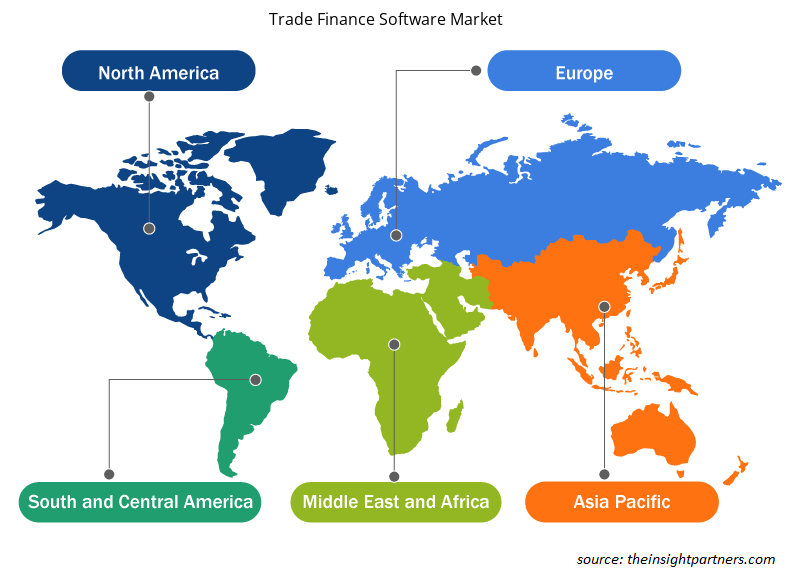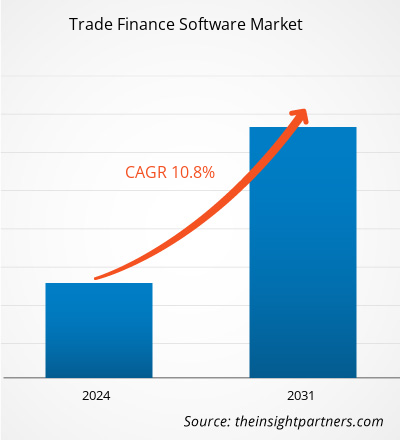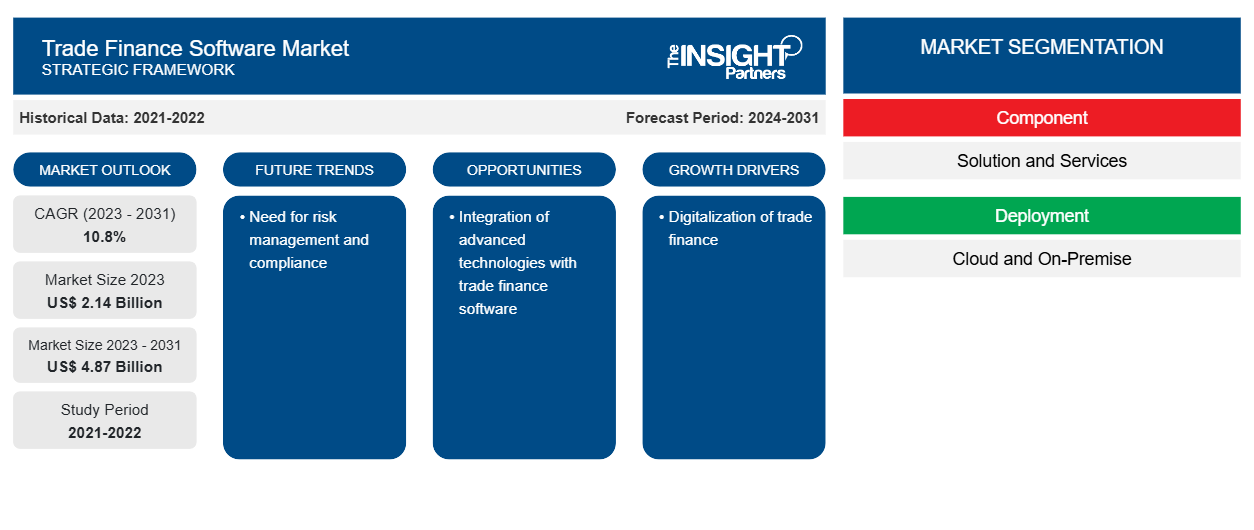貿易金融ソフトウェア市場の規模は、2023 年の 21 億 4,000 万米ドルから 2031 年には 48 億 7,000 万米ドルに達すると予測されています。市場は 2023 年から 2031 年にかけて 10.8% の CAGR を記録すると予想されています。デジタル化の進展とクラウドベースのテクノロジーの採用は、今後も貿易金融ソフトウェア市場の主要なトレンドであり続けると思われます。
貿易金融ソフトウェア市場分析
貿易金融プロセスのデジタル化が進むことは、貿易金融ソフトウェア市場の成長を後押しする大きな要因です。効率性の向上とコストの削減により、電子文書とクラウドベースの貿易金融ソリューションが従来の紙ベースの方法に取って代わるようになり、市場の成長に貢献しています。
貿易金融ソフトウェア市場の概要
透明性と国際貿易規制の遵守の必要性から、リアルタイムの監視およびレポート機能を備えたソフトウェア ソリューションの採用が促進されています。国際貿易の変化するニーズを満たす最先端のソリューションを提供することに重点を置く貿易金融ソフトウェア市場は、世界の貿易環境が変化し続け、企業がより安全で効率的な貿易金融業務を求める中、さらなる拡大が見込まれています。
要件に合わせてレポートをカスタマイズする
このレポートの一部、国レベルの分析、Excelデータパックなど、あらゆるレポートを無料でカスタマイズできます。また、スタートアップや大学向けのお得なオファーや割引もご利用いただけます。
-
このレポートの主要な市場動向を入手してください。この無料サンプルには、市場動向から見積もりや予測に至るまでのデータ分析が含まれます。
貿易金融ソフトウェア市場の推進要因と機会
貿易金融のデジタル化が市場に有利に
さまざまな業界の企業が、国際貿易業務を迅速化し、改善するために最先端のソリューションが必要であることを認識するにつれて、市場は大幅に拡大しています。この市場には、サプライチェーンファイナンス、コンプライアンス管理、請求書ファクタリング、クレジット管理などの貿易金融手順を改善および自動化するために作成されたソフトウェアプログラムが含まれます。組織は、貿易取引の複雑さと量の増加の結果として、手作業と時間のかかるタスクを削減し、精度を向上させ、国際貿易に関連するリスクを最小限に抑えるために貿易金融ソフトウェアに目を向けており、これがさらに市場プレーヤーによる貿易金融ソフトウェアの採用につながっています。たとえば、2023年11月、金融ソフトウェアアプリケーションとマーケットプレイスの世界的なプロバイダーであるFinastraは、国際コーポレートバンクであるCQUR BankがFinastraと提携してテクノロジー戦略を実行したことを発表しました。Finastraの市場をリードするソリューションであるTrade InnovationとCorporate Channelsを実装することで、CQUR Bankは企業顧客にシームレスなユーザーエクスペリエンスを提供する新しいオンラインバンキングポータルを提供し、新しいデジタルワークフローを導入し、ホスト間統合ソリューションを提供します。
リスク管理とコンプライアンスの必要性
リスク管理とコンプライアンスの向上に対するニーズの高まりも、貿易金融ソフトウェア市場の成長を後押しする要因の 1 つです。貿易金融ソフトウェアは、国際貿易に関連するリスクを追跡および軽減するための、詐欺検出、マネーロンダリング防止(AML) チェック、貿易法および制裁への準拠など、高度なツールを提供します。企業や金融機関が法律や規制のコンプライアンスを維持しながら国際貿易の課題に対処しようとしているため、これらのソフトウェア ソリューションのニーズは高まり続けています。
貿易金融ソフトウェア市場レポートのセグメンテーション分析
貿易金融ソフトウェア市場分析の導出に貢献した主要なセグメントは、コンポーネント、展開、企業規模、および最終用途です。
- コンポーネントに基づいて、市場はソリューションとサービスに分割されています。ソリューションセグメントは2023年に大きな市場シェアを占めました。
- 展開別に見ると、市場はクラウドとオンプレミスに分かれています。2023年にはクラウドセグメントがより大きな市場シェアを占めました。
- 企業規模別に見ると、市場は大企業と中小企業に分かれています。中小企業セグメントは最も高い CAGR で成長すると予想されています。
- 最終用途別に見ると、市場は銀行、トレーダー、その他に分類されます。銀行セグメントは2023年に大きな市場シェアを占めました。
貿易金融ソフトウェアの地域別市場シェア分析
貿易金融ソフトウェア市場レポートの地理的範囲は、主に北米、アジア太平洋、ヨーロッパ、中東およびアフリカ、南米/中南米の 5 つの地域に分かれています。
収益面では、北米は2023年に最大の貿易金融ソフトウェア市場シェアを占めました。北米は技術ソリューションを早期に導入しており、それが市場シェアの急上昇につながっています。中小企業によるクラウドベースの技術の採用は市場の成長につながります。銀行のデジタル化の急速な進展により、貿易金融ソフトウェアの需要がさらに高まり、北米の貿易金融市場シェアを押し上げています。
貿易金融ソフトウェア市場の地域別洞察
予測期間を通じて貿易金融ソフトウェア市場に影響を与える地域的な傾向と要因は、Insight Partners のアナリストによって徹底的に説明されています。このセクションでは、北米、ヨーロッパ、アジア太平洋、中東およびアフリカ、南米および中米にわたる貿易金融ソフトウェア市場のセグメントと地理についても説明します。

- 貿易金融ソフトウェア市場の地域別データを入手
貿易金融ソフトウェア市場レポートの範囲
| レポート属性 | 詳細 |
|---|---|
| 2023年の市場規模 | 21億4千万米ドル |
| 2031年までの市場規模 | 48億7千万米ドル |
| 世界のCAGR(2023年~2031年) | 10.8% |
| 履歴データ | 2021-2022 |
| 予測期間 | 2024-2031 |
| 対象セグメント |
コンポーネント別
|
| 対象地域と国 |
北米
|
| 市場リーダーと主要企業プロフィール |
|
貿易金融ソフトウェア市場のプレーヤー密度:ビジネスダイナミクスへの影響を理解する
貿易金融ソフトウェア市場は、消費者の嗜好の変化、技術の進歩、製品の利点に対する認識の高まりなどの要因により、エンドユーザーの需要が高まり、急速に成長しています。需要が高まるにつれて、企業は提供内容を拡大し、消費者のニーズを満たすために革新し、新たなトレンドを活用し、市場の成長をさらに促進しています。
市場プレーヤー密度とは、特定の市場または業界内で活動している企業または会社の分布を指します。これは、特定の市場スペースに、その市場規模または総市場価値に対してどれだけの競合相手 (市場プレーヤー) が存在するかを示します。
貿易金融ソフトウェア市場で事業を展開している主要企業は次のとおりです。
- CGI株式会社
- コマーチSA
- IBSFINテック
- ICSファイナンシャルシステムズ株式会社
- MITech - Make Intuitive Tech SA
- ニュージェン ソフトウェア テクノロジーズ株式会社
免責事項:上記の企業は、特定の順序でランク付けされていません。

- 貿易金融ソフトウェア市場のトップキープレーヤーの概要を入手
貿易金融ソフトウェア市場のニュースと最近の動向
貿易金融ソフトウェア市場は、重要な企業出版物、協会データ、データベースを含む一次および二次調査後の定性的および定量的データを収集することによって評価されます。以下は、市場の動向の一覧です。
- 2022 年 9 月、デジタル トランスフォーメーション製品の世界的大手プロバイダーである Newgen Software は、ムンバイでの顧客ミーティングで世界初のローコード トレード ファイナンス プラットフォームを発表しました。トレード ファイナンスは、大量の書類、複数の利害関係者、コンプライアンス要件を伴う複雑なプロセスです。Newgen の包括的で構成可能で将来を見据えたトレード ファイナンス プラットフォームは、銀行がペーパーレス化を進め、エンドツーエンドのトレード プロセスを合理化すると同時に、国内および国際規制へのコンプライアンスを確保するのに役立ちます。(出典: CXOtoday、プレス リリース、2022 年)
- 2024 年 2 月、金融ソフトウェア アプリケーションおよびマーケットプレイスの世界的プロバイダーである Finastra と、世界的なデジタル変革コンサルティングおよびインテグレーターである Tesselate は、貿易金融のデジタル化をより迅速かつ容易にする、エンドツーエンドのパッケージ化されたサービスを開始すると発表しました。Finastra Trade Innovation および Corporate Channels を搭載した Tegula Trade Finance as a Service により、米国の銀行は手動プロセスを自動化し、市場投入までの時間と価値を短縮して新しい需要に適応できます。Finastra の FusionFabric.cloud を介して、銀行は人工知能、ブロックチェーン、自動化ツールなどの最新技術を使用するフィンテック アプリケーションをシームレスに統合することもできます。(出典: Finastra、プレスリリース、2024 年)
貿易金融ソフトウェア市場レポートの対象範囲と成果物
「貿易金融ソフトウェア市場の規模と予測(2021〜2031年)」レポートでは、以下の分野をカバーする市場の詳細な分析を提供しています。
- 対象範囲に含まれるすべての主要市場セグメントの世界、地域、国レベルでの市場規模と予測
- 市場の動向(推進要因、制約、主要な機会など)
- 今後の主な動向
- 詳細なPEST/ポーターの5つの力とSWOT分析
- 主要な市場動向、主要プレーヤー、規制、最近の市場動向を網羅した世界および地域の市場分析
- 市場集中、ヒートマップ分析、主要プレーヤー、最近の動向を網羅した業界の状況と競争分析
- 詳細な企業プロフィール
- 過去2年間の分析、基準年、CAGRによる予測(7年間)
- PEST分析とSWOT分析
- 市場規模価値/数量 - 世界、地域、国
- 業界と競争環境
- Excel データセット
最新レポート
関連レポート
お客様の声
購入理由
- 情報に基づいた意思決定
- 市場動向の理解
- 競合分析
- 顧客インサイト
- 市場予測
- リスク軽減
- 戦略計画
- 投資の正当性
- 新興市場の特定
- マーケティング戦略の強化
- 業務効率の向上
- 規制動向への対応























 無料サンプルを入手 - 貿易金融ソフトウェア市場
無料サンプルを入手 - 貿易金融ソフトウェア市場